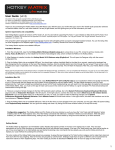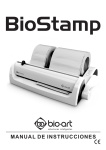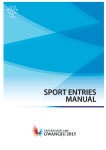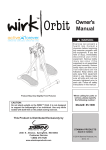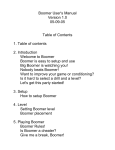Download sports tech
Transcript
ISSUE 10 | AUGUST 2014 HOW TO COACH ANALYTICS TO IMPROVE SPORTS PERFORMANCE 2 LETTER FROM THE EDITOR Welcome to this issue of Sports Performance & Tech. The first thing I am sure you have all noticed is that, in the longer-than-normal gap between issues, we have undergone a revamp of the magazine. Thanks to the work of Joe Sanderson, Sports Performance & Tech is now looking better than ever. Another reason for the long gap is that we are moving to a bi-monthly model, meaning that we will have a magazine coming out every two months. The reasons for this is that we are in the final stages of developing our new websites, which will bring you more content than ever before. It is worth watching this space for all developments on that. This edition looks at the use of analytics in coaching, looking at new products that are helping to create the next generation of data driven coaches and informed athletes. From the use of wearable technologies, to the abundance of new static technology, we wanted to bring you the latest ideas in this area. As always, if you like the magazine please share it. It was SPORTS PERFORMANCE & TECH created to spread ideas and if you think there is something in here that somebody else would find interesting please send it along to them. If you have any questions or feedback please contact me at [email protected] George Hill Managing Editor Managing Editor: George Hill Assistant Editors Simon Barton Art Director: Joe Sanderson Advertising: Hannah Sturgess [email protected] Are you looking to put your products in front of key decision makers? For Advertising contact Hannah at [email protected] Contributors: Dan Paterson Dr. Paulo Ottermann William Tubbs Kimberley French Richard Angus General Enquiries: [email protected] AUGUST 2014 CONTENTS 17 ANALYTICS IN FIGURE SKATING 10 KEEPING YOURSELF HYDRATED WITH MC10 With hydration taking centre stage at the World Cup, we speak to MC10 about their new patch Competitive figure skating is becoming more and more technical - we look at how analytics is affecting the ice 13 THE RACKET THAT LETS YOU COACH YOURSELF Do you want to play like Rafael Nadal? We look Babolat’s racket that lets you coach yourself 4 AN INTERVIEW WITH LYNXFIT’S NOBLE ACKERSON We speak to Noble Ackerson about Lynx and how they’re utilising Google Glass for fitness improvement 26 22A LOOK AT SHOT TRACKER TO CREATE DATA DRIVEN COACHES As the official fuel of the Giro D’italia, we see how Multipower’s new bar shapes up 32MAXI NUTRITION PROCOMP INFINITI Paulo Oppermann takes us through the ProComp Infiniti and how it’s helping athletes reach optimal performance 22 DATA DRIVEN COACHES As the world’s of basketball and analytics collide, we look at how Shot Tracker are helping tomorrows superstars fulfil their potential CYCLONE MILK Courtney Lawes uses it, so we thought we should test out Maxi Nutrition’s new cyclone milk product 34SPORTS TECH REVIEW: 34 JERSEYS TO KEEP YOU COOL 38 MULTIPOWER FRUIT POWER BAR 39 ITHLETE HRV TRACKER AN INTERVIEW WITH LYNXFIT CEO NOBLE ACKERSON Simon Barton | Assistant Editor AN INTERVIEW WITH LYNXFIT CEO NOBLE ACKERSON The mass launch of smart glasses was always likely to be met with a hint of scepticism; it’s customary for us to be suspicious towards technologies that differ from what we’re used to. The initial scepticism surrounding wearables though may have gone, with 4 million units predicted to be sold in 2014. In previous editions of Sports Performance and Tech we have looked at a number of fitness trackers - but there are several elements that divides Lynxfit from the crowd. With that in mind, I spoke to Noble Ackerson, CEO, at LynxFit, about their new fitness platform ahead of his appearance at the Sports & Fitness Innovation Summit, San Francisco in September. enthusiasts. It gives them a virtual coach that interacts with and updates them on how they’re progressing and developing as an athlete. Noble says; ‘People want to work out on their terms’ and that they don’t need a personal trainer for motivation as they’re an expensive option that can only be used at designated times. Clearly though, working with a personal trainer gives the consumer accountability and a degree of pressure to pursue their fitness goals actively. However, the LynxFit also gives them this through a vocal coach that allows for workouts to be undertaken at a pace that the user is safe and comfortable with. 5 This accountability is due to the willingness of their customers to share their information with their peers. Noble says; ‘A lot of users were sending their data and pictures of their stats as they were working out’ and that the social element of the application allowed them to compete with friends and share their progress. The FitBit has had a lot of success in this remit, and the ability to share data on social networks has taken their product on leaps and bounds. The social side of the LynxFit is looking to replicate this success by fostering that competitive spirit which is sometimes lost when working out alone. ‘LynxFit is a platform that leverages the motion capabilities of Google Glass, smart watches, wrist mounted variables – as long as it has an accelerometer and we have access to the hardware – we can do some pretty innovative stuff’ For Noble, Google Glass was the perfect platform to outreach content – as he says ‘the marketing buzz we got from being on Google Glass was great’. Above and beyond that, the Glass is clearly a very appropriate platform for fitness SPORTS PERFORMANCE & TECH 6 AN INTERVIEW WITH LYNXFIT CEO NOBLE ACKERSON ‘ Your journey to optimum fitness through the LynxFit is achieved through a combination of consumer input and machine learning. ‘Eventually it will be a body Your journey to optimum fitness through the LynxFit is achieved through a combination of consumer input and machine learning. worn, artificial intelligence fitness coach that will be with you whilst you workout’. The sensors on the product feed their data engine to give consumers real-time feedback SPORTS PERFORMANCE & TECH – Noble gives an example of this by saying ‘if you were on a run, and the data showed that you had run your fourth mile today quicker than the fourth mile you ran yesterday, it would say good job and let you know how you can continue to improve’. Having this information at your disposal can act as both a wake-up call and a pat on the back when you’ve been achieving your goals on a regular basis. It’s through this process that Noble was able to successfully run the Miami marathon, a challenge that takes more than just cardio, as Noble says ‘it’s a combination of running, yoga and gym work’ and by subscribing to these specific areas through the application, he was able to tailor his workout routine so that his marathon time was optimised ‘I subscribed to all the relevant categories of fitness that I needed to get to where I wanted to be’ This application is more than capable of being a great running partner – but there are a few functionality problems in AN INTERVIEW WITH LYNXFIT CEO NOBLE ACKERSON ‘ the gym. The application does need to be online for the data to be transferred and analysed correctly. This is however NCAA athletes have already picked up LynxFit as a way of improving their performance. something they’re working on through partnerships with universities and gyms, but for the time being this remains an issue, as generally gyms have either no Wi-Fi or poor network coverage. Their customer base has been drawn to the product due to its ability to offer insights that would otherwise be difficult to attain. They work with companies like P90X, the content provider whose DVD’s are meant to get you back in ‘beach’ shape in 3 months, and help them establish the patterns of their users. Noble says ‘We can tell them [P90X] women between the ages of 25 and 26 actually don’t complete 15 through to 20 of your content – because we’re looking for motion’. This is certainly an interesting way for a wearable company to 7 offer insights that wouldn’t necessarily be considered or possible with other products. This expands their capabilities as a company and potentially paves the way for a wider use of wearable technologies for both fitness and consumer insight. College athletes have already picked up LynxFit as a way of improving their performance. They’ve been using the technology as a pilot, improving their on-the-field strength and conditioning. However, Noble points out; ‘the ability to use sensors to help improve athletes to improve performance isn’t new – has been used with german soccer teams’. Noble seems to have a realistic view of things, which certainly bodes well for the company going forward - ‘We want to build a great product, but a viable business also. That uses wearables the ways wearables should be used’. Clearly it’s an exciting product and an interesting angle for the wearable market. SPORTS PERFORMANCE & TECH 8 SPORTS PERFORMANCE & TECH Sports & Fitness Innovation Summit wearable technology & digital innovation in sports September 10 & 11 San Francisco, 2014 Speakers include: For more information contact Sean Foreman +1 (415) 692 5514 [email protected] theinnovationenterprise.com/summits theinnovationenterprise.com/summits/sports-fitness-innovation-san-francisco KEEPING YOURSELF HYDRATED WITH MC10 George Hill | Managing Editor KEEPING YOURSELF HYDRATED WITH MC10 In February this year, FIFA granted former Italian coach, Cesare Prandelli’s proposal to introduce water breaks at the World Cup if the temperature rose above 32 degrees Celsius. Many in Europe felt that the humidity levels in Brazil would lower their chances of victory, despite the victors ultimately being Germany. FIFA’s Chief Medical Officer, Professor Jiri Dvorak, did his utmost to dispel the ‘heat issue’ in reaction to many camps claiming it to be a stumbling block for the success of the tournament. Nevertheless, these fears were realized in a last-sixteen match between Nigeria and France when French defender, Rafael Varane, spent an evening under observation in a hospital in Brasília for dehydration, signifying the importance of hydration in sport. A number of issues can arise when playing sport dehydrated, including; muscle cramps, strains and seizures. The importance of hydration is something that MC10 hold in high regard, in fact they have a hydration sensor as one of their core products. On their website it reads, ‘hydrate, hydrate, hydrate. Every athlete knows hydration levels are crucial to peak performance, but dehydration can sneak up on anyone, at any time’. The hydration sensor is only one cog in MC10’s machine, they’re a technology-platform that maps high-performance electronics into a virtually invisible patch. The concept of MC10 came to light in 2008, when founder John Rogers invented stretchable circuits, a platform that has enabled MC10 to strengthen. As Rodger’s brain child, he wanted to take electronics which were once confined to rigidity, and ‘ 11 To define the product, Isaiah says; ‘The concept is centered around this electronic tattoo that we have developed, coined the Biostamp, it allows the electronics to be thin and conformal to the body [in order] to create this seamless sensing experience, gathering data in the background’ Along with hydration, there are many uses for the platform. He says, ‘I would think about hydration as one hydrate, hydrate, hydrate. Every athlete knows hydration levels are crucial to peak performance, but dehydration can sneak up on anyone, at any time. make them adaptable and flexible enough so that they could fit to the human body. In order to get a better understanding of MC10s processes, I spoke to Isaiah Kacyvenski, Head of Sports and Fitness Segment at MC10. Isaiah is a former NFL football player, whose played for 8 years. He spent the majority of his career at the Seattle Seahawks before attending Harvard Business School and eventually putting his considerable experience into the hands of MC10. use case for this platform, we are really starting to look at muscle activity, heart rate, temperature - you think about all the different metrics you can measure’. Isaiah was keen to point to the importance of their head-impact technology with the Reebok Checklight. Product’s such as MC10’s are becoming more common, but they’re regularly targeted at one specific sport, and normally a sport where a helmet is necessary so that the sensor can be attached to it. SPORTS PERFORMANCE & TECH 12 ‘ MC10’s outreach is different, as Isaiah says; ‘We’ve taken our electronics and embedded them into a skull cap - it seamlessly fits on your head and you can forget about it’ I was playing a guessing game, I knew I was hydrating but I didn’t know how much I was losing Isaiah says; ‘I think it’s ridiculous to have to ‘put up’ with a device and I think MC10 is positioned perfectly to address that. We lower the barrier for wearability.’ Unfortunately, for many companies operating in the same space as MC10, the need to wear a clunky device in order to leverage the data insights has put some athletes off. It’s fair to say that when an athlete feels that something is hindering his/her performance, the first thing that will be sacrificed is the sensor equipment. This is why the skullcap formula is so important. Not only does the skullcap make the device more convenient, it allows for more accurate results. Isaiah sums this up nicely when he says; ‘I dont care what happens to the helmet, I care about what happens to the head and therein lies the issue, I don’t want a proxy I want to see exactly what is happening to the head’. These capabilities are really what capture MC10 and what makes their product so exciting. As mentioned before, helmet SPORTS PERFORMANCE & TECH KEEPING YOURSELF HYDRATED WITH MC10 centric sports, and primarily American Football, have been the main hunting ground for these tech-companies, but MC10 want to touch every sport. Isaiah says; ‘We are releasing a new head band world-wide that will concentrate on non-helmet sports, concentrating on soccer and basketball’. For soccer goalkeepers this development will be a welcome one - in the English Premier League last season, Tottenham Hotspur keeper, Hugo Lloris, was knocked out after colliding with Everton player Romelu Lukaku. He was allowed to carry on, despite the possibility of this leading to more serious problems. If Lloris was wearing the headband, information on the nature of the trauma could have been communicated to the doctors. Fortunately, nothing happened to Lloris, but severe head injuries are not uncommon in soccer and this is an issue that needs to be concentrated on. MC10’s product is not a diagnostic tool though and Isaish was keen to make this point; ‘It’s not diagnostic at all, it just gives an indication of however hard you've been hit’. Their insights are communicated through a simple traffic light system that makes complex data into an actionable one for doctors and consumers. With a concentration on player fitness and wellbeing at the core of the company, it is going to be something that only improces as the public becomes more concerned with the welfare of players. THE RACKET THAT LETS YOU COACH YOURSELF THE RACKET THAT LETS YOU COACH YOURSELF Richard Angus Summit Director, Sports Analytics Summit 14 If you were watching the final of Roland Garros on June 8th you can’t have helped but notice each and every commentator’s desire to make a point through data. Whether it was Nadal’s imperious 90-1 five-set record on clay or the importance of winning the first set in the final, talk of data was commonplace. This certainly isn’t a gripe against commentators – far from it, the use of data made the final more absorbing as debates were shaped through fact instead of conjecture. As we have touched upon numerous times in Sports Performance and Tech, tennis and data are very much a good match - it’s a highly data orientated game with insights easily transferable to coaches. It’s not just about improving your groundstrokes, the performance metrics are far narrower – be it court positioning or the RPM’s a player generates and the effect that has, depending on the court surface. I recently saw an infographic that showed how Nadal’s 3330 RPM forehand kicks up almost twice as high on clay as it does on grass, making it almost impossible to return without drastic footwork and positioning adjustment. This SPORTS PERFORMANCE & TECH Neale Cousland / Shutterstock.com THE RACKET THAT LETS YOU COACH YOURSELF facet of Nadal’s game makes him a unique challenge on clay, as the average RPM for top players is around 1,900 - a marked difference. ‘ but the Babolat Play Pure Drive is going some way to filling it. tennis and data are very much a match made in heaven This article is very Nadal-centric not only because he won Roland Garros but also because he is the face of Babolat Play Pure Drive. If you’re an amateur runner or a cyclist there’s an abundance of technology out there to help you improve your game. If you’re an amateur tennis player, however, there isn’t a huge amount out there to assist you. The reason why the Babolat Play Pure Drive is such an interesting development is because it is plugging a gap in a sport where data has been used so extensively at its highest level. This gap still remains at the amateur level The Babolat Play Pure Drive uses sensors integrated into its handle to allow players to access information that wasn’t previously available. This allows them to access a number of metrics that allow for the measurement of performance. THE RACKET THAT LETS YOU COACH YOURSELF ‘ If racquets like the Babolat Play Pure Drive become widespread then why wouldn’t the top players use them?heaven There are a number of metrics to get your teeth stuck into – you can dissect all of your strokes in detail, whether it’s the spin you put on the ball or the velocity you hit it at. Additionally, If you’re like me, then after an hour hit, it feels like you’ve been on court for about 15 minutes, the play pure drive will measure the time the ball was in play so that the time you spend picking up balls isn’t actually factored into the amount of time you think you have spent practicing. If you’ve enjoyed the wars of attrition that Nadal and Djokovic seemingly put themselves through every time they hit the court together, it’ll be of interest that the racquet estimates the energy expended on court. I would personally be really interested to see how much effort Nadal and Djokovic put in against each other when compared to an opponent in the first round of a Grand Slam – I think it would be a real eye opener and demonstrate the vast difference in ability between a player ranked at 50 and in the Top 5. Neale Cousland / Shutterstock.com You could argue that data analysis through the Babolat Play Pure Drive, especially at amateur level, is not a tool that shows you how to beat a specific player, but it does offer insights that were non-existent before. By analysing data on a match, or over a longer period of time, coaches can start to paint a picture as to whether their player is playing to his strengths, playing with enough variety or being too defensive. Clearly, it’s not quite IBM’s slam tracker, but for the average club-player these insights can elevate their standard exponentially. 15 altering the spin he gets on the ball. If racquets like the Babolat Play Pure Drive become widespread then why wouldn’t the top players use them? Any competitive advantage could be the difference between them winning a match or not. If we turn our attention back to Roland Garros, if any of the chasing pack want to stop Rafael Nadal from bringing in his 10th title next year, then data, through products like the Babolat Play Pure Drive, could be the only recourse they have left. For tennis players any data is good data, so there is no reason to suspect that ‘smart racquets’ won’t be common place on the professional tour relatively soon. That’s certainly the view of Babolat’s CEO, Eric Babolat, who expects the racquets to be commonplace on the ATP tour in the coming years. However, the likelihood of seeing the Babolat Play Pure Drive at Wimbledon and the US Open this year remains slim. One major gripe levelled at ‘smart racquets’ is that they can affect weight and string tension. According to Babolat, the weight of the racquet is exactly the same as previous models, which is a good thing as the slightest change in racquet weight can have a drastic effect on player performance at the highest level. Nadal doesn’t change the tension of his strings when the weather changes for fear of SPORTS PERFORMANCE & TECH Sports Analytics Innovation Summit September 10 & 11 San Francisco, 2014 Speakers include: For more information contact Sean Foreman +1 (415) 692 5514 [email protected] theinnovationenterprise.com/summits theinnovationenterprise.com/summits/sports-analytics-innovation-summit-sf-2014 ANALYTICS IN FIGURE SKATING Kimberley French NISA Qualified Coach 18 Over the years competitive figure skating has become increasingly more technical and complex in performance skills; there is therefore a much higher demand now from skaters and coaches to introduce new equipment and learning techniques into training programmes. ‘ For many years coaches have trained skaters on more complicated jumps like doubles and triples by using a harness. The skater would be strapped into a safety harness, usually either hand held or ceiling tracked, then launched into the air when approaching a jump, enabling the skater to feel the rotation. Many coaches today, however, feel that the harness is not the best tool because of skaters failing to use the correct muscles accurately in order to build muscle memory, in which case the skater may not benefit. Coaches generally favour the hand held harness as it enables the skater to prepare for a jump the same way in which they would normally. The hand held harness 'assists' the skater into ANALYTICS IN FIGURE SKATING the jump and into the landing, rather than 'lifting' the skater. The harness, however, is still used successfully, especially for skaters attempting triple and quadruple jumps; use of the ceiling harness at this elite standard of skating offers the skater a greater feeling of continued rotation when lifting into a jump, at the apex, and when descending, resulting in a more effective execution of the required number of rotations in the air. Now, as skating techniques are changing and the demands in competition are higher, there is a search for new creative training ideas, and coaches are looking to make skills more difficult to master rather than making them easier. An example is the use of weighted clothing in training schedules in order to increase the level of difficulty for a skater when jumping. Clothing such as weighted jackets are ideal for a quick and easy change, adding extra weight to the skater and therefore increasing the difficulty of lift into the air which creates a Now, as skating techniques are changing and the demands in competition are higher, there is a search for new creative training ideas SPORTS PERFORMANCE & TECH further demand on athlete strength, explosive power and the mastering of correct techniques which are essential for completing jumps successfully. ANALYTICS IN FIGURE SKATING ‘ The skater must train harder, using every ounce of power and strength they have to lift high enough to complete the required number of rotations and land with precision. Training this way takes time, ...the skater is then more likely to perform the jump with ease, fluidity and refinement. patience and determination for both athlete and coach as generally skills can get worse before getting better. Once the skater shows improvement and becomes more proficient when attempting jumps, the weighted clothing can be removed; the skater is then more likely to perform the jump with ease, fluidity and refinement.Further to the use of weighted clothing, equipment such as the 'training mask' is used on the ice to increase difficulty in breathing when performing a programme or routine. All skills and elements such as footwork, steps, jumps, spins and artistic movements must still be performed with the same intensity and enthusiasm than in a competition. The use of the training mask intensifies cardio and high altitude training by reducing the amount of oxygen the body can take in, ultimately affecting the way muscles 19 react and therefore the overall performance; this method intensifies the cardio training for the skater, making the ability to breathe and perform difficult. Once the skater has become more proficient with this training technique over time the mask can be removed, enabling the skater to perform their programme of required skills and elements with increased stamina. The introduction of such equipment makes training far more difficult for the athlete but certainly is effective in its ability to conclude with a greater quality performance. SPORTS PERFORMANCE & TECH 20 ANALYTICS IN FIGURE SKATING ‘ With this type of intense and demanding training comes the necessity for more durable and inventive training attire. Modern skating boots are extremely rigid to support the foot and ankle in jumps, and are cut just over ankle height to allow the foot to flex. Rigidity of the boot makes good fit essential, for this reason many skaters either order custom boots or have them 'bumped out' over pressure points by a skate technician. In recent years, boots made of synthetic materials with heat-mouldable linings have become popular with skaters because they combine strength with lighter SPORTS PERFORMANCE & TECH With this type of intense and demanding training comes the necessity for more durable and inventive training attire. weight than leather boots and are easier to break in; however, this decreases the amount of time the skates retain durability, often resulting in the purchase of new boots far more regularly. Elite skaters tend to prefer hard, strong durable boots made from leather due to their support and longevity. Many manufacturers today are creating more innovative designs in ice skates in order to offer a greater range in style, strength, design and weight depending on requirements and preferences of each individual. In addition to these modern ice skating boots comes the necessity for exceptionally creative blade design. It is essential that skaters trust their blades and that there are options to suit requirements for each individual. Blades are designed with various edge suitability, toe pick size and shape, rocker size (turning point on the blade or ball of the foot), all of which depends on a skater's level, skills being attempted, skating style and personal preference. 21 ANALYTICS IN FIGURE SKATING ‘ Figure skating blades are usually made of tempered carbon steel that are first heat treated and then coated with high quality chrome. In recent years, however, lightweight aluminium and stainless steel blades have also become popular. According to John Wilson, designers and manufacturers of ice skating blades based in Sheffield, ‘Revolution is the pinnacle in blade technology combining the traditional merits of a steel blade alongside the benefits of weight reduction and flexibility through the use of carbon The results are unparalleled composites. The results are unparalleled. The fusion of old and new technology allows skaters to move across the ice at increased speeds, make higher jumps, and cushion-land them, with greater control to reduce the risk of injury’. Revolution blades have become extremely popular throughout the skating world, especially because of the stunning design and the option to have the blades 'crystallised’, notorious for 'blinging' the skater's feet! It has become apparent, however, that due to the intricate detail in design of the blade, it is difficult for skaters to perform overhead tricks precisely, whereby grabbing the blade by the hand is essential. As techniques and technology progress through the years, competitive performances will become ever more complex and demands will become higher for all skaters. New ideas, creative training techniques and new technology in the world of ice skating is significantly fuelling and shaping the athletes of today, and will continue to do so for the foreseeable future. SPORTS PERFORMANCE & TECH A LOOK AT SHOT TRACKER TO CREATE DATA DRIVEN COACHES David Barton Summit Director, Sports A LOOK AT SHOT TRACKER TO CREATE DATA DRIVEN COACHES 23 The NBA is one of the most glamorous sporting organizations in the world, and Basketball is perhaps the ‘American’ sport that has the widest international appeal. The sport has experienced a boom in popularity in nations such as China, the Philippines and Spain, where their Liga ACB is widely considered to be one of the best leagues in the world, second only to the NBA. The global appeal of basketball means that more and more we are seeing children pick basketball as their sport of choice. It was even claimed by the FIBA Secretary General, Patrick Baumann, that; ‘If you look around the world and see the statistics of the world’s most popular sport in the age group 14-18, it’s basketball across all genders.’ If we take Baumann at face value, then basketball’s rise in popularity is an incredible achievement, especially considering the world-wide appeal of soccer. The popularity of basketball is also a real opportunity for analytics - it’s a sport with so much data potential, but with seemingly little coverage. Currently, analytical programs are only for the use of high-level college and NBA teams, whose budgets allow them to dish out $40,000 on a system. For the young kids practicing in their front-gardens this sort of system just isn’t attainable, and probably doesn’t enter their minds as a ‘must-have’ when playing. It was this notion however, that attracted me to Shot Tracker. I had the pleasure of speaking to Davyeon Ross, co-founder and COO at Shot Tracker about their product. Unlike many of the wearable-tech companies I have spoken to, Shot Tracker are different in that their primary target market was 7-17 year olds, not pro-athletes or soon-to-be pro-athletes. SPORTS PERFORMANCE & TECH 24 A LOOK AT SHOT TRACKER TO CREATE DATA DRIVEN COACHES Shot Tracker is wearable tech designed for basketball. Davyeon says; ‘we tried to deliver the product in materials that are already utilised in games like sweatbands’ . From my experience, wearable tech often lives and dies by its ability to function unnoticed when sport is being played and this was a view shared by Davyeon, he says; ‘we knew we had to build something that was light and almost invisible, the wrist sensor weighs less than 0.4 ounces, you can finish your workout and forget you’ve got it on’. With wearable tech still being in its infancy, a wrist sensor that weighs 0.4 ounces could only be the start, a prototype almost. In the words of Davyeon - ‘It’s at 0.4 ounces now, but we feel SPORTS PERFORMANCE & TECH this version is like the 1999 iPod, it’s huge and we have a ways to go’ . Ideally, Davyeon would like to see the Shot Tracker chip be so minute that it can fit into a ‘lance armstrong band’ - then it really would be unnoticeable. Gamification is central to Shot Tracker with the product tapping into most teenagers love for computer games, Davyeon says; ‘When you can play against your friends it’s a game changer, really’ and that ‘the process is very addictive and it drives usage - it’s like Xbox Live’. There are a whole host of different games you can play, and like Xbox Live, there’s a global leaderboard where you can challenge people from all over the world. As Davyeon says; ‘as it drives usage, they’re going to practice more which means they will get better’. Progression will be easy to document - as you start beating people you can be sure that you’re improving that shot and if you make the effort as a kid, if you practice for the day consisted of taking 100 shots by yourself, this process could become tedious very quickly - add the competitive element and everything changes, enthusiasm will be heightened as will the desire to improve so that you’ll be able to beat your challenger next time. To add to this, the same principal can be applied to movements around the court. A LOOK AT SHOT TRACKER TO CREATE DATA DRIVEN COACHES As Shot Tracker is targeted at a relatively youthful group, data visualisation is key. It has to be simple so that users aren’t put off by complexity or overly numerical findings. Davyeon says; ‘everyone’s data is their own so it’s extremely accessible- the visualisation techniques that we have used are very traditional because we wanted to make sure people were seeing what they’re accustomed to’. Bar, Pie and Shot charts are commonly used, but the most exciting element is the location technology. Davyeon explains the system by saying; ‘we have split the court into small grids and we can tell within 10 cm exactly where on the court you are - we can plot a very precise shot chart and the amount of shots you have done and the colour of the grid determines whether they’re hot or not’. These insights are incredibly valuable as it will allow young players to determine where they need to improve their game and perhaps more importantly it will show their coaches how their team is shaping up and what areas need to be looked at. Davyeon says ‘there are so many different forces in the game of basketball for us to be successful we had to eliminate false positives like Domenic Gareri / Shutterstock.com 25 the pass and the dribble while accurately identifying when a shot was taken and made, which is now included in the analytics.’ It was really interesting to speak to Davyeon about Shot Tracker. It’s a product that’s looking to break into a sport where analytics programmes at the amateur level are few and far between. With the gamificaction aspect added to it, young players will have a feedback mechanism that will allow them to measure their progress, because as Davyoen says; ‘without metrics you really don't know how you're doing and it’s hard to improve what you don't measure’ . SPORTS PERFORMANCE & TECH REVIEW: PROCOMP INFINITI Dr. Paulo Oppermann | Sports Scientist 27 PROCOMP INFINITI system from having undesired configuration changes during its use. When looking at advances in technology and sport sciences in elite level sports in the past few years, biofeedback, neurofeedback and neurophysiological measurements are being considered by top sport organizations as one of the most effective practices in performance enhancement, injury prevention, sleep improvement and injury recovery assistance. A number of devices can be used towards this ever growing field of sport sciences; however, few have the versatility and capabilities that the ProComp Infiniti, from Thought Technology has. This is a multi-modality device that may utilize up to 8 sensors/ adapters simultaneously - it has 6 sensor inputs that can provide up to 256 data samples per second, and 2 that operate at an even quicker sampling rate, offering up to 2048 data samples per second. The system is customizable, according to the type of implementation that is being used, and to the software package that is chosen by the user. Changing the settings is fairly simple, and the user manual provides users with a table informing how the switches need to be configured for each purpose – the switches can be flipped with the use of small pointed objects (like a paper clip), this protects the Among the things that this system may measure are: muscle activity (with the use of surface EMG electromyography), heart electrical activity (with the use of EKG - electrocardiogram), changes in blood volume pulse (with the use of a plethysmograph), skin surface temperature (with the use of surface thermometer), brain electrical activity (with the use of EEG - electroencephalogram), respiratory rhythm (with the use of thoracic or/and abdominal respiration sensor belt), body angle position (with the use of a goniometer), body angular torsion (with the use of a torsion ‘ This array of measurements makes this device one of the most comprehensive systems available on the market meter), forces applied (with the use of force gauge), inclination (with the use of an inclinometer), and reaction time (with the use of push buttons or push/release pedals). SPORTS PERFORMANCE & TECH 28 This array of measurements makes this device one of the most comprehensive systems available on the market – its versatility allows third party sensors and devices to be paired up with this system, including measurements from Polar belts, with the use of a specific receiver (this feature is particularly attractive when teaching an athlete how to control and selfregulate his/her heart rate - as they may take the Polar system anywhere). Another great feature is ProComp Infiniti’s size and portability. The system’s 8 channel receiver is a relatively small (37cm x 37cm x 10cm) plastic box, it uses a fiber optic cable to transmit the signals (which makes the transmission very quick, accurate and insulated from noise and electrical interference), a signal converter (from optical to USB format), and an USB cable - this configuration is best for uses when mobility isn’t necessary. For uses where motion is a factor (e.g. when athletes are moving, during practice or during competitions) it is possible to use telemetry – with a Bluetooth adapter that sends the signals directly to the laptop, allowing real-time tracking of athletes’ bio/neurophysiological measurements, and motion measurements – the telemetry’s SPORTS PERFORMANCE & TECH PROCOMP INFINTI signal range is pretty good, and is up to 100 meters, according to the manufacturer’s specifications (from my experience the unit can send the data reliably for up to 120 meters without obstructions and with the use of new batteries). Another option for mobile applications is the use of a compact flash card, this is ideal for situations where data can be analyzed after practice or competition – the data is stored in the card and, later on, sent to the laptop for analysis with the use of a compact flash reader. The receiver has a slot on the back that fits the compact flash card or the Bluetooth adapter. The receiver has a clip that allows it to be clipped onto the athlete’s shorts or pants; its construction is sturdy enough to endure significant motion from the user. When talking about portability, an important downside is the system’s battery cover that may come loose with motion from the athlete; this can be fixed with the use of a small piece of tape covering the battery lid and the receiver unit. In regards to batteries, the receiver utilizes 4 AA batteries. When using regular (non-rechargeable) alkaline batteries the battery life is about 15 hours when all channels are being used. It is important to highlight that it may last for many more hours with fewer channels in use (which is true for most of the use cases in sports); and that battery life is reduced if the telemetry/Bluetooth unit is being used. The unit has a power on/off button which has to be held for 1 second in order for the system to be turned on or off – this is a good feature as it prevents some of the unintended use of the button; a negative here is the fact that this button isn’t indented into the system’s case; instead, the button raises above the main surface of the front case, a fact that may cause unintended use from the athlete (especially if the receiver isn’t clipped onto the athlete’s shorts or pants on a place that may prevent this from happening – depending on the sport). 29 PROCOMP INFINITI ‘ In most cases the regular use of the system provides very reliable data, there aren’t many instances were electrical interference is a factor; nevertheless, when electromagnetic fields come into play the unit fails to do its job, the signals become completely erratic and useless, there is no noise filtering or data cleaning that will do The system is sturdy and able to endure motion without problems any good. The user’s manual recommends the receiver unit to be placed away from any electrical device to prevent the aforementioned interference from happening – my experience with the device is that interference will be a rare occurrence, but under some conditions synthetic grass, or artificial turf, will generate enough static electricity to compromise the unit’s use (as an alternative in such cases it is possible to insulate the unit by placing an insulator between the unit and the artificial turf). Sensor/adapter connections work very well and are simple to be paired with the receiver: there is a white dot by each of the channel connectors on the receiver unit, and there is a matching white dot on the connectors of each sensor/ adapter – the user needs to align these white dots and then press for a solid connection; even under the most extreme sport conditions these connections have been very reliable and the signal’s integrity has been sustained throughout its use. The system is sturdy and able to endure motion without problems; however, it is important for the user to be mindful about how to handle the connections, the sensor cables, and the fiber optic cable (especially when storing the system, when not in use) in order to extend the system’s longevity. ‘ The hardware can be used with the BioGraph Infiniti software provided by Thought Technology; this software package has suites for specific use cases, e.g. physiology suit, EEG suite, sports suite, and reaction time suite, among others. The software package allows for a comprehensive use of the system with sessions designed for different purposes, like baseline assessments, performance enhancement biofeedback training sessions, and others. For advanced users and use cases, and for personalization to each athlete’s preferred form of feedback, the software package comes with a screen editor, a session editor and a channel editor; this allows the use of specific graphics, animations, and sounds. From my experience when using biofeedback with athletes, it is ideal to tailor the feedback portion of the training to each athlete - this assists on session engagement and A negative factor is that this system is mainly designed for use by professionals, trainers, and sport science specialists; thus, personal use application accelerates the learning curve when athletes are being trained, taught performance enhancing techniques, using the feedback to assist on injury recovery, practicing sleep quality enhancing techniques and other things. The system’s price depends on the number of suites and sensors to be utilized by the user. A negative factor is that this system is mainly designed for use by professionals, trainers, and sport science specialists; thus, personal use applications SPORTS PERFORMANCE & TECH 30 can be very complicated and not intuitive, especially if the user hasn’t been given guidance by a professional or doesn’t have supervision. On the other hand, when utilized by a professional who can make full use of the system’s potential, the ProComp Infiniti can become the foundation for a successful sport sciences program for professional sport organizations looking SPORTS PERFORMANCE & TECH PROCOMP INFINTI to gain a competitive edge. The system provides accurate assessments for athletes’ talent and potential identification, provides solid feedback training sessions to assist on performance enhancement techniques (e.g. improving reaction time, focus, decision making, muscle response…), can be used to assist on injury recovery process (e.g. setting ideal muscle activity ranges, joint movement range…), to prevent injuries (determining ideal muscle activation ranges, ideal muscular readiness routines…), to assist athletes to improve sleep and recovery (determining important circadian rhythm factors impacting sleep quality, providing regulatory techniques to improve sleep, and reduce insomnia and time for sleep onset), among other goals. Do You Have The Next Game Changing Technology? Send It For Review [email protected] MAXI NUTRITION CYCLONE MILK Simon Barton | Assistant Editor MAXI NUTRITION CYCLONE MIX In the last edition of Sports Performance and Tech, one of our sports nutritionists used Maxi Nutrition’s latest protein powder on a three-month cycle with considerable success. With that in mind, I was particularly keen to get my hands on their latest release, the ‘cyclone milk’ - the first ever ready-to-drink protein milk with an added dose of liquid creatine and amino acids. As a brand, Maxi Nutrition are trying to spread protein use into a more mainstream sporting arena. Aspiring athletes often shy away from protein based products as it’s often been marketed around weight lifters and people looking to build mass. For Maxi Nutrition, protein and more importantly, creatine, is an essential tool for increased performance. Whether your aim is to run that last mile a little faster or putting some extra power behind your serve, both protein and creatine have an important role to play in your development. The people at Maxi Nutrition are obviously excited about the product and have made real strides with their cyclone milk. Chris Harrison, GSK Scientist and creator of Cyclone Milk said: ‘This has been two years in the making and the research we have done into stabilising creatine in liquid is extensive. I managed to stabilise creatine in a milk format by using the natural protective properties of whey and milk proteins. It’s a great achievement for me and for the team at GSK who have worked on this.’ Each 330ml bottle contains 30g of protein, 16g of carbohydrates, 3g of creatine and is fat free. In the words of Maxi Nutrition; ‘Creatine is the only ingredient proven to improve an exercisers strength and power in successive bursts of short term, high intensity exercise.’ For those of you who have tried creatine based products before, you’ll know that it isn’t particularly tasty, in fact, I’d go as far as to say that it’s one of those drinks that you’d rather consume quickly. I have actually heard a lot of people being put off creatine by the taste but the Cyclone Milk is a welcome respite from this – it has a good flavour but there’s still a slight aftertaste, but nothing like the unpleasantness that creatine users have had to go through in the past. 33 the taste, then 3g is a lot better than none, and it’s still enough to be making good progress. In a sense, it’s a happy medium and that will be a welcome addition for many. In truth, my cycle with the Cyclone milk hasn’t been long enough to give you a list of tangible results that the product has brought me, but it has, without doubt, increased my appetite for creatine. I almost looked forward to it after working out, which I can assure you, is an urge that I have never had with traditional creatine based products before. However, like everything that tastes nice, it’s not as good for you. For example, the Maxi Nutrition Powder that we reviewed in the last edition packed 5g of creatine – the cyclone milk only has 3g. But if you’re going to be put off by SPORTS PERFORMANCE & TECH 34 SPORTS TECH REVIEW H C E T S T R SPO REVIEW JERSEYS | FRUIT BAR | HRV TRACKER Jerseys To Keep You Cool It is the middle of the summer and we have just had the Tour de France. There has been an upsurge in popularity for cycling, but with the heat, many are put off. Therefore we are looking at two of the best summer cycling jerseys, designed to keep you cool and the Pearl Izumi Sprinter, designed to reduce effort through the latest high-tech SPORTS PERFORMANCE & TECH aerodynamic design. As a sport that is gaining more popularity across the world thanks to high quality equipment becoming more affordable, cycling is a fantastic way to maintain fitness in the off season without many of the traditional stresses that come from more high impact options. 35 SPORTS TECH REVIEW Rapha Super Lightweight FIT QUALITY Good fit without feeling too tight in general, movement is fluid and relatively easy. The one gripe that isn’t major, is the length. Given that the jersey comes up relatively short, it would be recommended to wear bib shorts with the jersey. We have come to expect top quality from Rapha and it is certainly the case with this jersey. It has a triple blend of polyester fabrics, they have unsurprisingly moved away from the Merino wool that they have become known for with their other jerseys. This has not detracted from the quality of the material, fit or durability. The only slight gripe with the jersey is that having tested the white model, it would require an undershirt to avoid being opaque. Although for many this would be an issue and may well be unavoidable, when factoring in the primary purpose of the jersey, it would add an extra layer of insulation. HEAT MANAGEMENT Very good. The jersey manages to keep you relatively cool even in very hot conditions. I found that the semi-mesh material used allowed air to flow very effectively. Even when using on the hottest days, when significant sweating occurred, it dried quickly and could be used within a few hours if required. COMFORT As with all Rapha jerseys, the Super Light is very comfortable, allowing for extended use even in hot and humid conditions. The placement of the pockets is also well thought out, meaning that they are easy to reach and with an added zip pocket, meant that keys, phones and other valuables stay in place. We have come to expect top quality from Rapha and it is certainly the case with this jersey. SPORTS PERFORMANCE & TECH 36 SPORTS TECH REVIEW Castelli Climber & Inferno Bib Shorts transfer of heat and keeping you cool throughout a ride. The lack of modesty (the top is a mesh and almost completely see through) is a small price to pay when you are testing in conditions north of 30 degrees/40 fahrenheit, like I was. One thing to note is that it is imperative to wear sun cream when using this kit, after not doing so, I ended up with a checkerboard sunburn. The shorts offer great heat management too, with a noticeable increase in airflow when cycling. FIT As with all Castelli kit, the fit on both the jersey and short are tight. However, compared to older models the ‘Large’ is closer to what you would expect to find in other brands and fitted me well. The very interesting aspect of these is that both are relatively opaque, meaning that when they are being worn it is important to wear both suncream and throw modesty out the window. Although for some this may be an issue (luckily on the shorts the only opaque areas are on the side of the legs) it has allowed for a superior heat management, which more than justifies it for me. HEAT MANAGEMENT Superb heat management, both the shorts and the jersey are some of the best that I have tried for the SPORTS PERFORMANCE & TECH COMFORT Castelli have designed the climber for when on the bike, meaning that when you initially put on the jersey, it feels almost unnatural, with the seams feeling like they are tight in the wrong places. When on the bike however, the merits of creating the jersey in this way becomes clear as when you begin the slight hunch it feels natural and the initial feeling of unease when just wearing the jersey is lost. QUALITY Despite the thin and seemingly flimsy nature of the jersey, the quality is high. The stitching is strong and the pocket placement and durability is good. One thing that I do feel is missing from the jersey is a grip strip at the base of the back as I found that the jersey would often ride up due to a relatively short fit. Although this is not so much of an issue when combined with bib shorts, I would feel more comfortable with having a grippy surface. The inferno shorts are also high quality, with a combination of 7 fabrics there was always going to a risk of pull on stitching between the two, but this was not the case. They are durable and feature the Progetto X2 Air seat pad, which in my opinion is one of the best pads on the market for both airflow and comfort whilst in the saddle, even after 4-5 hours of peddling in hot conditions. 37 SPORTS TECH REVIEW Pearl Izumi Speed Jersey FIT The fit is relatively tight as you would expect from a Jersey designed for sprinting, allowing for good aerodynamics and airflow. The material allows for a certain amount of flex too, which is good for those of us who are not built like track cyclists. Although tight, it does not feel uncomfortable at all, allowing for sufficient movement and flexibility. TECHNOLOGY Unlike the others reviewed in this issue, the Speed Jersey is not specifically designed for hot weather so I thought it was only fair to mention the key attribute of this jersey that makes it so interesting. The technology development behind this includes wind tunnel testing, work with Taylor Phinney and Marcel Kittel, two of the world’s top sprinters and knowledge of the skin suits that have been used by most professionals teams for past couple of years. They have created one of the most aerodynamically impressive jerseys in recent memory. With their dimpled Transfer Aero fabric and strategic seam placement, allowing for significant energy savings (around 8%). The result is surprisingly impressive even for a non-professional like myself, you can feel yourself cutting through the air and the increase in power and speed is marked. COMFORT Despite the design concentrating on speed, which necessitates a certain degree of tightness, the comfort does not suffer as a result. It can be worn for a considerable amount of time without discomfort, mainly because of the flatlock seams, meaning that there is no friction with the skin. QUALITY The quality of the material, stitching and overall construction of the jersey is good. The give from the material without being restrictive is an indictment to the quality of the garment as a whole and allows for a full range of movement despite the tight and aerodynamic design. SPORTS PERFORMANCE & TECH 38 SPORTS TECH REVIEW Multipower Fruit Power Bar MulitiPower’s ‘Fruit Power’ bar was the official fuel for the Giro d’italia. It’s an energy bar, and a tasty one at that. The bar is a mix of various fruits including Apple, Pineapple and Mango with grain also taking up a large proportion of the bar. As its primary goal is to give you a sustainable energy kick, it packs around 30g of carbohydrates. I would normally take one of the bars before working out at 06.30am and find that I wouldn’t feel my energy levels depleting until around 08.30AM, despite working out heavily, so clearly the product works well. Like most of us, I don’t want to eat anything unpleasant in the morning so it was a relief to be eating something that actually tasted nice. The bar has a really nice texture and doesn’t fall apart once it’s been opened - I’d say that the bar ticks all SPORTS PERFORMANCE & TECH the boxes in this department. However, at £35 for a box of 24, the MultiPower Fruit Bar is not cheap - in fact, that’s about £1.50 per bar. I’ve tested bars from SIS that are similar in taste but which cost around 50p less. In defence of MulitPower, their Fruit Bar is considerably higher in fruit than their competitors, which perhaps justifies the higher price. Overall, Mulitpower’s Fruit Power Bar is an excellent source of energy for those embarking on extensive training routines. It offers a healthier alternative to supermarket products and a sustainable lift that doesn’t just give you a spike of energy. I would give the product a chance, but just be willing to pay a little more for its benefits. Overall, Multipower’s Fruit Power Bar is an excellent source of energy for those embarking on extensive training routines. It offers a healthier alternative to supermarket products and a sustainable lift that doesn’t just give you a spike of energy. I would give the product a chance, but just be willing to pay a little more for its benefits. 39 SPORTS TECH REVIEW Ithlete HRV Tracker William Tubbs Summit Director, Sports Analytics Innovation For even the most knowledgeable athletes and gym-goers, working out can be a bit of a guessing game. Many applications push you to workout for either five or six days per week and set aggressive targets that can encourage burnout. The ithlete finger sensor is a break way from this train of thought and is instead looking at the importance of recovery. Quite simply, if you don’t recover, you’re unlikely to reap the benefits of your workout plan. The ithlete Finger Sensor is a quick and simple way to measure what intensity level you should train at on a given day, or whether you need a well-earned rest day. The product consists of a finger sensor and an application. It’s very simple to fire up - just put your finger in the sensor, press start and breath in through your nose and out through your mouth for one minute. It will then give you your heart rate value - these values will be in different colours’ that will represent how hard you should workout. If it’s green, you have the all clear to go as intense as you want. Amber, and you’re recommend a lower intensity session, normally aerobic. Finally, red implies that you need to rest. it can be viewed over much longer timeframes. The ithlete allows its users to be far more aware of how their body is reacting to their fitness plans. It’s a tool that is suited to those of us who work out on a regular basis and find it difficult to keep out of the gym even when our body is fighting it. Overall, I would highly recommend the product to anyone who is serious about health and fitness. Additionally, there are a variety of other metrics on their dashboard that can be measured using your heart rate variation. These include; sleep quality, fatigue, muscle soreness and stress levels, all of which are recorded and factored into your final score. The ithlete application will store and aggregate this data so that SPORTS PERFORMANCE & TECH Email [email protected] for more information FOLLOW @SPORTSPANDT LIKE GOO.GL/n9YU3x SUBSCRIBE GOO.GL/6PLFcl










































